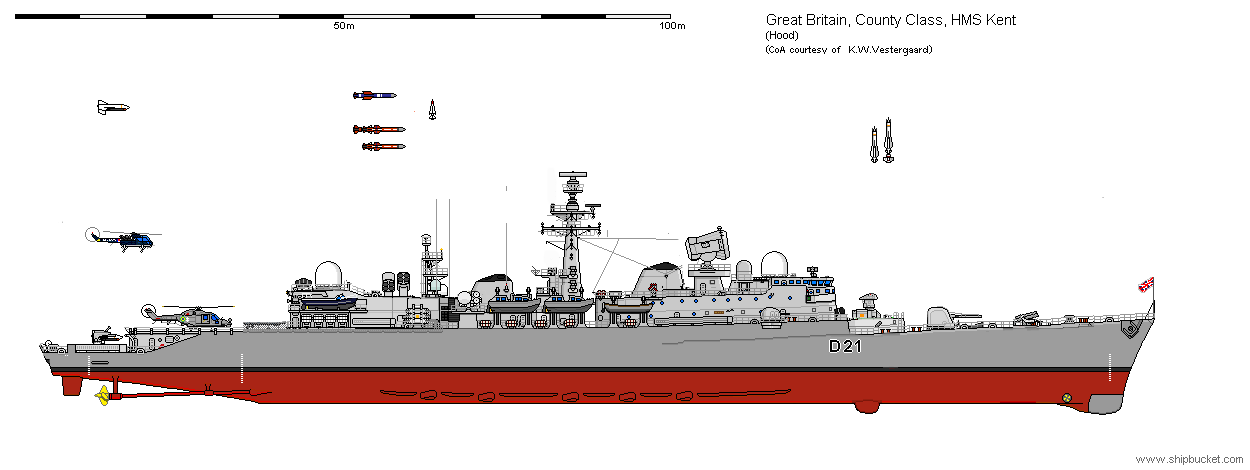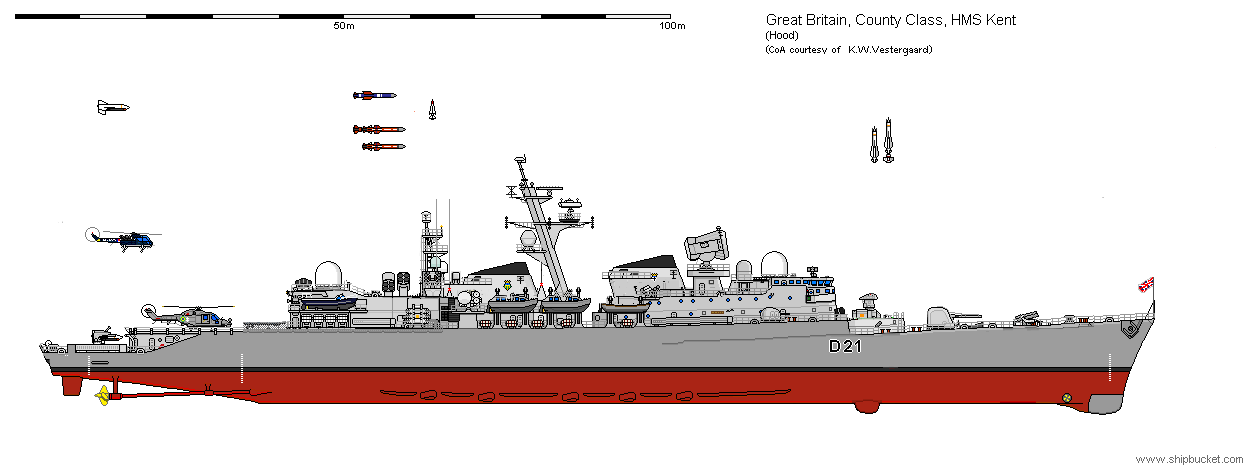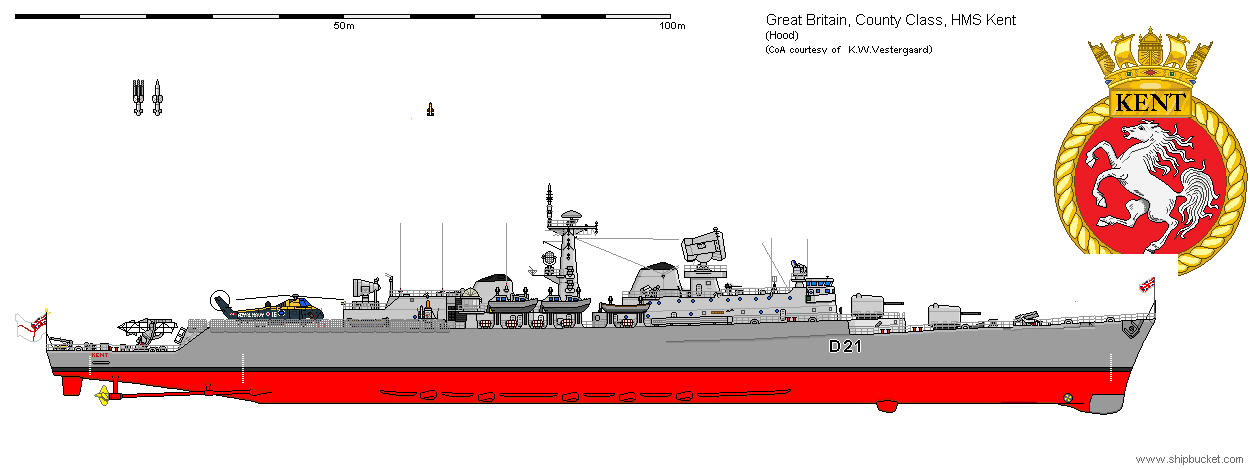So I'm in two minds here on whether this should be a alternative history thread or a hypothetical one?
In essence it could be classed as truly hypothetical, but some of the subsystems and even 'alternative' weapons are in fact clearly alternative history. So it's a bit 50/50 on which section. So I call ramble a bit here but hope to meander to a point.
Nevertheless, the question stands can it be achieved? A multirole warship, as the Type 82 was intended to be or more role specific as the Type 42 was.
Points to consider firstly. In no particular order.
1. the Type 42 with helicopter and 4.5" gun possesses quite a bit of multirole capability. Type 82's claim to this is really centred on its datalinks, combat system and Type 988 3D radar, sonar, Ikara being just the 'teeth' of the capability.
2. Type 82 lacking helicopter facilities lacked that flexibility. True a helicopter could land on it, but had to fly to a hanger equipped ship for maintenence and my understanding is that the helicopter was stored on a ship with a hanger, in effect not much more than a 'visitor' to the Type 82.
3. removing the 4.5" gun and helicopter facilities would certainly open up scope to either further reduce the size/cost of the Type 42 or design the ship to be less 'densely packed'.
4. the Type 42 was so densely packed that when it came to upgrading Sea Dart and the Type 42, the ship was quickly dropped and a new design sought. Type 43 and later Type 44 (reusing the Type 22 hull/propulsion design). This in turn, thanks to the likely parsimony of the Sea Dart II option being considered, was undermined and the whole issue even after the Falklands ended up being sucked into NFR-90, NAAWS, FAAMS, FUN, FUNGI and 'Horizon'.
5. In the light of the rising costs of the Type 82 design, 'cheap' ships were sought, and this (which ended up being the Type 19 prior to the basis of the future fleet being changed) was subject to lots of studies and lots of compromises.
Consider the desire for Sea Mauler, a far more capable system and Sea Cat, but the US dropping the Mauler program left the UK with the nearterm option of Sea Cat and a longterm effort to develop their own weapon. Ultimately Sea Wolf, but this proved to exert notable costs on the warship in terms of the space and weight to cope with the computers and sensors.
So in this light.....
conceptually one can see that various components raised the costs of multirole and left the idea of a large force of multirole warships floundering.
But in truth the very concept of multirole was more open and fluid than the one represented by the Type 82.
Yet in turn it is possible to design and build a multirole warship and the costs of production and standardisation drive down the costs such that the warship can be bought in larger numbers.
Strictly speaking for a given limit on personnel numbers, ships which are multirole are more efficient crew-wise, since the addition of extra crew for a system is less than the crew required for a separate new ship. If a multirole ship needs 400 crew, and a more role specific ship needs say 250, then the achievement of covering all roles assuming it takes two such ships demands a total personnel force of 500. Thus the multirole ship actually 'saves' 100 personnel.
Factoring up to a force of 10 multirole ships, you'd need 20 specific role ships and the difference between 4000 and 5000 is enough to crew another 2 multirole ships and still have 200 personnel left over.
I keep the figures the same because this avoids the 'scale of production' isssues, where ordering more of something brings down the purchase and operational costs, enabling more to be bought and used.
But this again masques the deeper matter, that for a given peacetime operation, one might not ever need a specific system and it's associated staff.
In fact for a lot of operations, in peacetime most of the wartime systems are utterly superfluous and a waste of space, crew and ultimately money.
SO what was needed?
Clearly a cheaper 3D radar if that is deemed necessary. Type 988 was a wasted effort, and ultimately only two sets of the Dutch system ever went to sea.
A common medium range SAM that is as common as possible between services, as this brings down the costs to each service. Sea Dart did not deliver this, either across UK forces or across other allies navies (as the tripartite effort over what led to Sea Wolf shows).
And that takes us to the short range SAM, again commonality and scale of production was lacking.
A common gun for the same reasons.
By sticking with the 4.5" gun, the RN excluded itself from the USN, MN, and the UK Army from compatibility or use of something being ordered in bulk by others.
So to fix this....?
Either Sea Dart should have been ordered to replace Bloodhound, or some other weapon that could be used across services developed.
Either Mauler or PT.428 developed and neither Rapier or Sea Wolf pursued.
Either a 105mm gun, a 5" or a 6" gun pursued. Ideally being a common development at least in ammunition terms with the Army, or in total system terms with other navies.
And the what seems the correct choice was to focus on helicopters for ASW rather than Ikara, but this should have happend earlier.
In propulsion terms the use of COSAG was really too cautious a step on the Type 82 (especially considering both the success of the County's and the fact the reuse of this plant was dropped), and going 'all GT'.
While such a ship might be termed a Type 82, it would share little with HMS Bristol as she became.
In essence it could be classed as truly hypothetical, but some of the subsystems and even 'alternative' weapons are in fact clearly alternative history. So it's a bit 50/50 on which section. So I call ramble a bit here but hope to meander to a point.
Nevertheless, the question stands can it be achieved? A multirole warship, as the Type 82 was intended to be or more role specific as the Type 42 was.
Points to consider firstly. In no particular order.
1. the Type 42 with helicopter and 4.5" gun possesses quite a bit of multirole capability. Type 82's claim to this is really centred on its datalinks, combat system and Type 988 3D radar, sonar, Ikara being just the 'teeth' of the capability.
2. Type 82 lacking helicopter facilities lacked that flexibility. True a helicopter could land on it, but had to fly to a hanger equipped ship for maintenence and my understanding is that the helicopter was stored on a ship with a hanger, in effect not much more than a 'visitor' to the Type 82.
3. removing the 4.5" gun and helicopter facilities would certainly open up scope to either further reduce the size/cost of the Type 42 or design the ship to be less 'densely packed'.
4. the Type 42 was so densely packed that when it came to upgrading Sea Dart and the Type 42, the ship was quickly dropped and a new design sought. Type 43 and later Type 44 (reusing the Type 22 hull/propulsion design). This in turn, thanks to the likely parsimony of the Sea Dart II option being considered, was undermined and the whole issue even after the Falklands ended up being sucked into NFR-90, NAAWS, FAAMS, FUN, FUNGI and 'Horizon'.
5. In the light of the rising costs of the Type 82 design, 'cheap' ships were sought, and this (which ended up being the Type 19 prior to the basis of the future fleet being changed) was subject to lots of studies and lots of compromises.
Consider the desire for Sea Mauler, a far more capable system and Sea Cat, but the US dropping the Mauler program left the UK with the nearterm option of Sea Cat and a longterm effort to develop their own weapon. Ultimately Sea Wolf, but this proved to exert notable costs on the warship in terms of the space and weight to cope with the computers and sensors.
So in this light.....
conceptually one can see that various components raised the costs of multirole and left the idea of a large force of multirole warships floundering.
But in truth the very concept of multirole was more open and fluid than the one represented by the Type 82.
Yet in turn it is possible to design and build a multirole warship and the costs of production and standardisation drive down the costs such that the warship can be bought in larger numbers.
Strictly speaking for a given limit on personnel numbers, ships which are multirole are more efficient crew-wise, since the addition of extra crew for a system is less than the crew required for a separate new ship. If a multirole ship needs 400 crew, and a more role specific ship needs say 250, then the achievement of covering all roles assuming it takes two such ships demands a total personnel force of 500. Thus the multirole ship actually 'saves' 100 personnel.
Factoring up to a force of 10 multirole ships, you'd need 20 specific role ships and the difference between 4000 and 5000 is enough to crew another 2 multirole ships and still have 200 personnel left over.
I keep the figures the same because this avoids the 'scale of production' isssues, where ordering more of something brings down the purchase and operational costs, enabling more to be bought and used.
But this again masques the deeper matter, that for a given peacetime operation, one might not ever need a specific system and it's associated staff.
In fact for a lot of operations, in peacetime most of the wartime systems are utterly superfluous and a waste of space, crew and ultimately money.
SO what was needed?
Clearly a cheaper 3D radar if that is deemed necessary. Type 988 was a wasted effort, and ultimately only two sets of the Dutch system ever went to sea.
A common medium range SAM that is as common as possible between services, as this brings down the costs to each service. Sea Dart did not deliver this, either across UK forces or across other allies navies (as the tripartite effort over what led to Sea Wolf shows).
And that takes us to the short range SAM, again commonality and scale of production was lacking.
A common gun for the same reasons.
By sticking with the 4.5" gun, the RN excluded itself from the USN, MN, and the UK Army from compatibility or use of something being ordered in bulk by others.
So to fix this....?
Either Sea Dart should have been ordered to replace Bloodhound, or some other weapon that could be used across services developed.
Either Mauler or PT.428 developed and neither Rapier or Sea Wolf pursued.
Either a 105mm gun, a 5" or a 6" gun pursued. Ideally being a common development at least in ammunition terms with the Army, or in total system terms with other navies.
And the what seems the correct choice was to focus on helicopters for ASW rather than Ikara, but this should have happend earlier.
In propulsion terms the use of COSAG was really too cautious a step on the Type 82 (especially considering both the success of the County's and the fact the reuse of this plant was dropped), and going 'all GT'.
While such a ship might be termed a Type 82, it would share little with HMS Bristol as she became.



